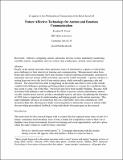| dc.contributor.author | Picard, Rosalind W. | |
| dc.date.accessioned | 2010-06-30T19:47:26Z | |
| dc.date.available | 2010-06-30T19:47:26Z | |
| dc.date.issued | 2009-12 | |
| dc.identifier.issn | 0264-3839 | |
| dc.identifier.uri | http://hdl.handle.net/1721.1/56009 | |
| dc.description.abstract | People on the autism spectrum often experience states of emotional or cognitive overload that
pose challenges to their interests in learning and communicating. Measurements taken from
home and school environments show that extreme overload experienced internally, measured as
autonomic nervous system (ANS) activation, may not be visible externally: a person can have a
resting heart-rate twice the level of non-autistic peers, while outwardly appearing calm and
relaxed. The chasm between what is happening on the inside and what is seen on the outside,
coupled with challenges speaking and being pushed to perform, is a recipe for a meltdown that
may seem to come “out of the blue,” but in fact may have been steadily building. Because ANS
activation both influences and is influenced by efforts to process sensory information, interact
socially, initiate motor activity, produce meaningful speech, and more, deciphering the dynamics
of ANS states is important for understanding and helping people on the autism spectrum. This
paper highlights advances in technology that can comfortably sense and communicate ANS
arousal in daily life, allowing new kinds of investigations to inform the science of autism while
also providing personalized feedback to help individuals who participate in the research. | en_US |
| dc.description.sponsorship | Microsoft Corporation | en_US |
| dc.description.sponsorship | National Science Foundation | en_US |
| dc.description.sponsorship | Nancy Lurie Marks Family Foundation | en_US |
| dc.description.sponsorship | Things That Think Consortium | en_US |
| dc.language.iso | en_US | |
| dc.publisher | Royal Society of London | en_US |
| dc.relation.isversionof | http://dx.doi.org/10.1098/rstb.2009.0143 | en_US |
| dc.rights | Attribution-Noncommercial-Share Alike 3.0 Unported | en_US |
| dc.rights.uri | http://creativecommons.org/licenses/by-nc-sa/3.0/ | en_US |
| dc.source | Alex Khitrik [akhitrik@media.mit.edu] after request by Rosalyn Picard | en_US |
| dc.subject | Affective computing | en_US |
| dc.subject | autism | en_US |
| dc.subject | autonomic nervous system | en_US |
| dc.subject | ambulatory monitoring | en_US |
| dc.subject | wearable sensors | en_US |
| dc.subject | sympathetic nervous system | en_US |
| dc.subject | skin conductance | en_US |
| dc.subject | arousal | en_US |
| dc.subject | stress and anxiety | en_US |
| dc.title | Future affective technology for autism and emotion communication | en_US |
| dc.type | Article | en_US |
| dc.identifier.citation | Picard, Rosalind W. “Future affective technology for autism and emotion communication.” Philosophical Transactions of the Royal Society B: Biological Sciences 364.1535 (2009): 3575-3584. | en_US |
| dc.contributor.department | Program in Media Arts and Sciences (Massachusetts Institute of Technology) | en_US |
| dc.contributor.approver | Picard, Rosalind W. | |
| dc.contributor.mitauthor | Picard, Rosalind W. | |
| dc.relation.journal | Philosophical transactions of the Royal Society B Biological sciences | en_US |
| dc.eprint.version | Author's final manuscript | |
| dc.type.uri | http://purl.org/eprint/type/SubmittedJournalArticle | en_US |
| eprint.status | http://purl.org/eprint/status/PeerReviewed | en_US |
| dspace.orderedauthors | Picard, R. W. | en |
| dc.identifier.orcid | https://orcid.org/0000-0002-5661-0022 | |
| mit.license | OPEN_ACCESS_POLICY | en_US |
| mit.metadata.status | Complete | |
